Performance Enhancement of Solar Still Unit Using v-Corrugated Basin, Internal Reflecting Mirror, Flat-Plate Solar Collector and Nanofluids
Abstract
1. Introduction
2. Thermal Analysis
- The glass cover has the same area Ag as the water film Aw.
- The water film and the glass cover are gray surfaces.
- The water film is maintained at a constant temperature Tw.
- The glass cover is taken at a constant temperature Tgi.
- There is constant and equal specific heat C for feed, brine, and distillate.
- The sky can be considered as a black body.
- The glass cover is exposed only to the sky.
- Heat balance for the still basin (b)
- Heat balance for water in the basin (w)
- Heat balance for the glass cover (g) can be determined using Equation (3).
- The condensate rate is given by Equation (4) [23].
3. Materials and Methods
3.1. Experimental Set-Up
3.2. Solar Still Configurations
3.3. Solar Still Performance Parameters
- (a)
- Solar still productivity (Pd)
- (b)
- Solar still thermal efficiency (ηth)
- (c)
- Basin surface area (Ab)
3.4. Experimental Proceedings and Measurements
4. Uncertainty Analysis
5. Results and Discussion
5.1. Comparative Temperature Analysis of Solar Still Configurations
5.2. Comparative Productivity Analysis of Solar Still Configurations
5.3. Comparative Thermal Efficiency Analysis of Solar Still Configurations
6. Comparative Assessment with Current Study
7. Conclusions
Author Contributions
Funding
Institutional Review Board Statement
Informed Consent Statement
Data Availability Statement
Acknowledgments
Conflicts of Interest
Nomenclature
| a | Accuracy of instrument |
| Ab | Basin surface area (m2) |
| Ag | Glass cover surface area (m2) |
| Aw | Water surface area (m2) |
| Cpw | Specific heat of seawater (J/kg·K) |
| Cpb | Basin specific heat (J/kg·K) |
| Cpg | Glass cover specific heat (J/kg·K) |
| Fc | Convective fraction |
| Fe | Evaporative fraction |
| Fr | Radiative fraction |
| K | Thermal conductivity (W/m.K) |
| kg | Glass cover thermal conductivity (W/m.K) |
| kin | Insulation thermal conductivity (W/m.K) |
| n | Particle shape factor |
| I | Solar radiation flux incident on the basin (Wm−2) |
| Lw | Latent heat of vaporization (kJ kg−1) |
| m | Flow rate of seawater with and without nanofluids (kg/s) |
| mb | Basic mass (kg) |
| mc | Mass of condensated water (kg) |
| mg | Mass of the glass cover (kg) |
| mw | Water mass (kg) |
| Qex | Energy supplied by the nanofluid circulated in the copper tubes of solar collector to saline water (J/h) |
| Qe,w−gi | Evaporative heat transfer rate within still from the water surface to the interior surface of the glass cover (Wm−2) |
| qb | Conductive heat transfer rate from the basin bottom to the atmosphere (Wm−2) |
| qbwb | Convective heat transfer rate from the black basin liner to the water surface (Wm−2) |
| qcga | Convective heat transfer rate from the exterior surface of the glass cover to the atmosphere (Wm−2) |
| qcw | Convective heat transfer rate within still from the water surface to the interior surface of the glass cover (Wm−2) |
| qrgs | Radiative heat transfer rate from the exterior surface of the glass cover to the sky (Wm−2) |
| qrwb | Radiative heat transfer rate within still from the water surface to the interior surface of the glass cover (Wm−2) |
| q1 | Total value of the energy transfer within the still from the water surface to the interior surface of the glass cover (Wm−2) |
| q2 | Total value of the energy transfer from the exterior surface of the glass cover to the atmosphere (Wm−2) |
| hbw | Convective heat transfer coefficient from the black basin liner to the water surface (Wm−2 °C−1) |
| hcga | Convective heat transfer coefficient from the exterior surface of the glass cover to the atmosphere (Wm−2 °C−1) |
| hcw | Convective heat transfer coefficient from water surface to the interior surface of the glass cover (Wm−2 °C−1) |
| hew | Evaporative heat transfer coefficient from water surface to the interior surface of the glass cover (Wm−2 °C−1) |
| he,w−gi | Evaporative heat transfer coefficient from water surface to glass cover (Wm−2 °C−1) |
| hrgs | Radiative heat transfer coefficient from the exterior surface of the glass cover to the sky (Wm−2 °C−1) |
| hrw | Radiative heat transfer coefficient from the water surface to the interior surface of the glass cover (Wm−2 °C−1) |
| h1 | Total internal heat transfer coefficient from the water surface to the interior surface of the glass cover (Wm−2 °C−1) |
| h2 | Total external heat transfer coefficient from the exterior surface of the glass cover to the atmosphere (Wm−2 °C−1) |
| Tw | Basin water temperature (°C) |
| Tin | Inlet temperature in the FPSC still with and without nanofluids in 1 h (°C) |
| Tout | Outlet temperature in the FPSC still with and without nanofluids in 1 h (°C) |
| Tao | Ambient temperature (°C) |
| Tv | Vapor temperature (°C) |
| Tsky | Sky temperature (°C) |
| Tgo | Outer glass cover temperature (°C) |
| Tgi | Inner glass cover temperature (°C) |
| u | Standard uncertainty |
| ΔTw-gi | Temperature difference between the hot basin water surface and the interior cooling glass cover surface (°C) |
| Ug | Conductive heat transfer coefficient through the thickness of the still cover Wm−2 °C−2 |
| W | Vel°City of wind (m/sec) |
| xg | Glass cover thickness (m/s) |
| xin | Insulation thickness (m/sec) |
| Pd | Hourly condensate (distillate) production from the still (kgh–1) |
| Pgi | Partial pressure of water vapor at inner glass temperature within the still (Nm−2) |
| Pwb | Partial pressure of water vapor at water temperature within the still (Nm−2) |
| Abbreviations | |
| SS | Solar still |
| CSS | Conventional solar still |
| MSS | Modified solar still |
| FPSC | Flat-plate solar collector |
| HDH | Humidification-dehumidification |
| MSF | Multi-stage flash |
| MED | Multi-effect distillation |
| VC | Vapor compression |
| Subscripts | |
| bf | base fluid |
| nf | nanofluid |
| p | nanoparticle |
| u | useful |
| Greek letters | |
| ηth | Solar still thermal efficiency (%) |
| ηFPSC | Solar still-solar collector thermal efficiency (%) |
| ρ | Density of fluid (kg/m3) |
| ϕ | Concentration ratio by volume of nanoparticles |
| εeff | Shape factor of diffuse radiation between the water surface and the glass cover (effective emissivity) |
| σ | Stefan -Boltzmann constant (Wm−2 K−4) |
References
- Ibrahim, A.G.M.; Elshamarka, S.E. Performance study of a modified basin type solar still. Sol. Energy 2015, 118, 397–409. [Google Scholar] [CrossRef]
- Elbany, M.; Elhenawy, Y. Analyzing the ultimate impact of COVID-19 in Africa. Case Stud. Transp. Policy 2021, 9, 796–804. [Google Scholar] [CrossRef]
- Sharshir, S.W.; Yang, N.; Peng, G.; Kabeel, A.E. Factors affecting solar stills productivity and improvement techniques: A detailed review. Appl. Therm. Eng. 2016, 100, 267–284. [Google Scholar] [CrossRef]
- Shukla, S.K.; Sorayan, V.P.S. Thermal modeling of solar stills: An experimental validation. Renew. Energy 2005, 30, 683–699. [Google Scholar] [CrossRef]
- Kabeel, A.E.; Hamed, A.M.; El-Agouz, S.A. Cost analysis of different solar still configurations. Energy 2010, 35, 2901–2908. [Google Scholar] [CrossRef]
- Al-Hayek, I.; Badran, O.O. The effect of using different designs of solar stills on water distillation. Desalination 2004, 169, 121–127. [Google Scholar] [CrossRef]
- Chan, W.W.; Jiang, B.; Liu, L. Comparative studies of solar collectors in southern China hotels. J. China Tour. Res. 2013, 9, 292–304. [Google Scholar] [CrossRef]
- Tanaka, H. Monthly optimum inclination of glass cover and external reflector of a basin type solar still with internal and external reflector. Sol. Energy 2010, 84, 1959–1966. [Google Scholar] [CrossRef]
- Omara, Z.M.; Hamed, M.H.; Kabeel, A.E. Performance of finned and corrugated absorbers solar stills under Egyptian conditions. Desalination 2011, 277, 281–287. [Google Scholar] [CrossRef]
- Eltawil, M.A.; Omara, Z.M. Enhancing the solar still performance using solar photovoltaic, flat plate collector and hot air. Desalination 2014, 349, 1–9. [Google Scholar] [CrossRef]
- Sheeba, K.N.; Babu, J.S.-C.; Jaisankar, S. Performance evaluation of a flat plate collector coupled solar still system. Energy Sources Part A Recovery Util. Environ. Eff. 2015, 37, 291–298. [Google Scholar] [CrossRef]
- Rai, S.N.; Tiwari, G. Single basin solar still coupled with flat plate collector. Energy Convers. Manag. 1983, 23, 145–149. [Google Scholar] [CrossRef]
- Badran, O.O.; Al-Tahaineh, H.A. The effect of coupling a flat plate collector on the solar still productivity. Desalination 2005, 183, 137–142. [Google Scholar] [CrossRef]
- Badran, O.O. Experimental study of the enhancement parameters on a single slope solar still productivity. Desalination 2007, 209, 136–143. [Google Scholar] [CrossRef]
- Tanaka, H. Experimental study of a basin type solar still with internal and external reflectors in winter. Desalination 2009, 249, 130–134. [Google Scholar] [CrossRef]
- Hiroshi, T.; Yasuhito, N. Theoretical analysis of a basin type solar still with internal and external reflectors. Desalination 2006, 197, 205–216. [Google Scholar]
- Omara, Z.M.; Kabeel, A.E.; Younes, M.M. Enhancing the stepped solar still performance using internal and external reflectors. Energy Convers. Manag. 2014, 78, 876–881. [Google Scholar] [CrossRef]
- Omara, Z.M.; Kabeel, A.E.; Abdullah, A.S.; Essa, F.A. Experimental investigation of corrugated absorber solar still with wick and reflectors. Desalination 2016, 381, 111–116. [Google Scholar] [CrossRef]
- Abdallah, S.; Badran, O.; Mazen, M.; Khader, A. Performance evaluation of a modified design of a single slope solar still. Desalination 2008, 219, 222–230. [Google Scholar] [CrossRef]
- Hameed, H.G.; Diabil, H.A.N.; Al-Fahham, M.A. Performance study on a solar concentrator system for water distillation using different water nanofluids. Heliyon 2023, 9, e16535. [Google Scholar] [CrossRef]
- Zakaria, M.; Sharaky, A.M.; Al-Sherbini, A.-S.; Bassyouni, M.; Rezakazemi, M.; Elhenawy, Y. Water desalination using solar thermal collectors enhanced by nanofluids. Chem. Eng. Technol. 2022, 45, 15–25. [Google Scholar] [CrossRef]
- Fouad, K.; Alalm, M.G.; Bassyouni, M.; Saleh, M.Y. A novel photocatalytic reactor for the extended reuse of W–TiO2 in the degradation of sulfamethazine. Chemosphere 2020, 257, 127270. [Google Scholar] [CrossRef] [PubMed]
- Abu-Arabi, M.; Zurigat, Y.; Al-Hinai, H.; Al-Hiddabi, S. Modeling and performance analysis of a solar desalination unit with double-glass cover cooling. Desalination 2002, 143, 173–182. [Google Scholar] [CrossRef]
- Baum, V.A.; Bairamov, R. Heat and mass transfer processes in solar stills of hot-box type. Sol. Energy 1964, 8, 78. [Google Scholar] [CrossRef]
- Dunkle, R.V. Solar water distillation: The roof-type still and a multiple- effect diffusion still. In International Developments in Heat Transfer, ASME, Proceedings International Heat Transfer Part V; University of Colorado: Victoria, Australia, 1961; p. 895. [Google Scholar]
- Fernandez, J.L.; Chargoy, N. Multi stage indirectly heated solar still. Sol. Energy J. 1990, 44, 215–223. [Google Scholar] [CrossRef]
- Duffie, J.A.; Beckman, W.A. Solar Engineering of the Thermal Process; Wiley: New York, NY, USA, 1991; pp. 3–44. [Google Scholar]
- Tiwari, A.K.; Tiwari, G.N. Thermal modeling based on solar fraction and experimental study of the annual and seasonal performance of a single slope passive solar still: The effect of water depths. Desalination 2007, 207, 184–204. [Google Scholar] [CrossRef]
- Cooper, P.I. Digital simulation of experimental solar still data. Sol. Energy 1973, 14, 451. [Google Scholar] [CrossRef]
- Sartori, E. Solar still versus solar evaporator: A comparison study between their thermal behaviors. Sol. Energy 1996, 56, 199–206. [Google Scholar] [CrossRef]
- McAdams, W.H. Heat Transmission, 3rd ed.; McGraw-Hill Book Company: New York, NY, USA, 1954. [Google Scholar]
- Swinbank, Long-wave radiation from clear skies. Q. J. R. Meteorol. Soc. 1963, 89, 339–348. [CrossRef]
- Rai, G.D. Solar Energy Utilization. A Text Book for Engineering Students; Some additional methods of solar energy utilization; Khanna: Delhi, India, 1980; Chapter 12; pp. 194–197. [Google Scholar]
- Hamdan, M.A.; Musa, A.M.; Jubran, B.A. Performance of solar still under Jordanian climate. Energy Conserv. Manag. 1999, 40, 495–503. [Google Scholar] [CrossRef]
- Ebaid, M.S.; Al-busoul, M.; Ghrair, A.M. Performance enhancement of photovoltaic panels using two types of nanofluids. Heat Transf. 2020, 49, 2789–2812. [Google Scholar] [CrossRef]
- Sardarabadi, M.; Hosseinzadeh, A.; Kazemian, M. Passandideh-Fard, Experimental investigation of the effects of using metal-oxides/water nanofluids on a photovoltaic thermal system (PVT) from energy and exergy viewpoints. Energy 2017, 138, 682–695. [Google Scholar] [CrossRef]
- Michael, J.J.; Iniyan, S. Performance analysis of a copper sheet laminated photovoltaic thermal collector using copper oxide–water nanofluid. Sol. Energy 2015, 119, 439–451. [Google Scholar] [CrossRef]
- Sharaf, O.Z.; Orhan, M.F. Thermodynamic analysis and optimization of densely-packed receiver assembly components in high-concentration CPVT solar collectors. Energy Convers. Manag. 2016, 121, 113–144. [Google Scholar] [CrossRef]
- Poredoš, P.; Tomc, U.; Petelin, N.; Vidrih, B.; Flisar, U.; Kitanovski, A. Numerical and experimental investigation of the energy and exergy performance of solar thermal, photovoltaic and photovoltaic-thermal modules based on roll-bond heat exchangers. Energy Convers. Manag. 2020, 210, 112674. [Google Scholar] [CrossRef]
- Radwan, A.; Ahmed, M.; Ookawara, S. Performance enhancement of concentrated photovoltaic systems using a microchannel heat sink with nanofluids. Energy Convers. Manag. 2016, 119, 289–303. [Google Scholar] [CrossRef]
- Sardarabadi, M.; Passandideh-Fard, M.; Heris, S.Z.J. Experimental investigation of the effects of silica/water nanofluid on PV/T (photovoltaic thermal units). Energy 2014, 66, 264–272. [Google Scholar] [CrossRef]
- Gupta, B.; Mandraha, T.; Edla, P.; Pandya, M. Thermal modeling and efficiency of solar water distillation: A review. Am. J. Eng. Res. 2013, 2, 203–213. [Google Scholar]
- Manokar, A.; Vimala, M.; Winston, D.; Ramesh, R.; Sathyamurthy, R.; Nagarajan, P.; Bharathwaaj, R. Different parameters affecting the condensation rate on an active solar still—A review. Env. Prog. Sustain. Energy 2019, 38, 286–296. [Google Scholar] [CrossRef]
- Mabrouk, A.N.; Elhenaw, Y.; Abdelkader, M.; Shatat, M. The impact of baffle orientation on the performance of the hollow fiber membrane distillation. Desalination Water Treat. 2017, 58, 35–45. [Google Scholar] [CrossRef]
- Muraleedharan, M.; Singh, H.; Udayakumar, M.; Suresh, S. Modified active solar distillation system employing directly absorbing Therminol 55–Al2O3 nano heat transfer fluid and Fresnel lens concentrator. Desalination 2019, 457, 32–38. [Google Scholar] [CrossRef]
- Elhenawy, Y.; Moustafa, G.H.; Attia, A.M.; Mansi, A.E.; Majozi, T.; Bassyouni, M. Performance enhancement of a hybrid multi effect evaporation/membrane distillation system driven by solar energy for desalination. J. Environ. Chem. Eng. 2022, 10, 108855. [Google Scholar] [CrossRef]
- Gupta, S.V. Measurement Uncertainties: Physical Parameters and Calibration of Instruments; Springer Science & Business Media: Berlin/Heidelberg, Germany, 2012. [Google Scholar]
- Kirkup, L.; Frenkel, R.B. An Introduction to Uncertainty in Measurement: Using the GUM (Guide to the Expression of Uncertainty in Measurement); Cambridge University Press: Cambridge, UK, 2006. [Google Scholar]
- Alhathal Alanezi, A.; Bassyouni, M.; Abdel-Hamid, S.M.; Ahmed, H.S.; Abdel-Aziz, M.H.; Zoromba, M.S.; Elhenawy, Y. Theoretical investigation of vapor transport mechanism using tubular membrane distillation module. Membranes 2021, 11, 560. [Google Scholar] [CrossRef]
- Omara, Z.M.; Kabeel, A.E.; Younes, M.M. Enhancing the stepped solar still performance using internal reflectors. Desalination 2013, 314, 67–72. [Google Scholar] [CrossRef]
- Diabil, H.A.N. Experimental study to enhance the productivity of single-slope single-basin solar still. Open Eng. 2022, 12, 157–168. [Google Scholar] [CrossRef]
- Balachandran, G.B.; David, P.W.; Mariappan, R.K.; Kabeel, A.E.; Athikesavan, M.M.; Sathyamurthy, R. Improvising the efficiency of single-sloped solar still using thermally conductive nano-ferric oxide. Environ. Sci. Pollut. Res. 2020, 27, 32191–32204. [Google Scholar] [CrossRef] [PubMed]
- Sharshir, S.W.; Elsheikh, A.H.; Ellakany, Y.M.; Kandeal, A.W.; Edreis, E.M.A.; Sathyamurthy, R.; Thakur, A.K.; Eltawil, M.A.; Hamed, M.H.; Kabeel, A.E. Improving the performance of solar still using different heat localization materials. Environ. Sci. Pollut. Res. 2020, 27, 12332–12344. [Google Scholar] [CrossRef]
- Kabeel, A.E.; Attia, M.E.H.; Bellila, A.; El-Maghlany, W.M.; Fayed, M.; Abdullah, A.S.; Zidane, I.F. The impact of the corrugated absorber shape on the performance of a hemispherical solar still for water desalination: An experimental study. Appl. Water Sci. 2023, 13, 108. [Google Scholar] [CrossRef]
- Attia, M.E.H.; Zayed, M.; Abdelgaied, M.; Sharshir, S.; Kabeel, A.E.; Abdalla, A. Experimental investigation on a modified design of hemispherical solar distiller with v-corrugated iron trays and wick materials for improving freshwater production. Environ. Sci. Pollut. Res. 2022, 29, 83756–83769. [Google Scholar] [CrossRef]
- Ramzy, K.; Abdelgaleel, M.; Kabeel, A.E.; Mosalam, H. Performance of a single slope solar still using different porous absorbing materials: An experimental approach. Environ. Sci. Pollut. Res. 2023, 30, 72398–72414. [Google Scholar] [CrossRef]
- Bellatreche, R.; Ouali, M.; Balistrou, M.; Tassalit, D. Thermal efficiency improvement of a solar desalination process by parabolic trough collector. Water Supply 2021, 21, 3698–3709. [Google Scholar] [CrossRef]
- Sambare, R.K.; Dewangan, S.K.; Gupta, P.K.; Joshi, S. Augmenting the productivity of tubular solar still using low-cost energy storage materials. Environ. Sci. Pollut. Res. 2022, 29, 78739–78756. [Google Scholar] [CrossRef] [PubMed]
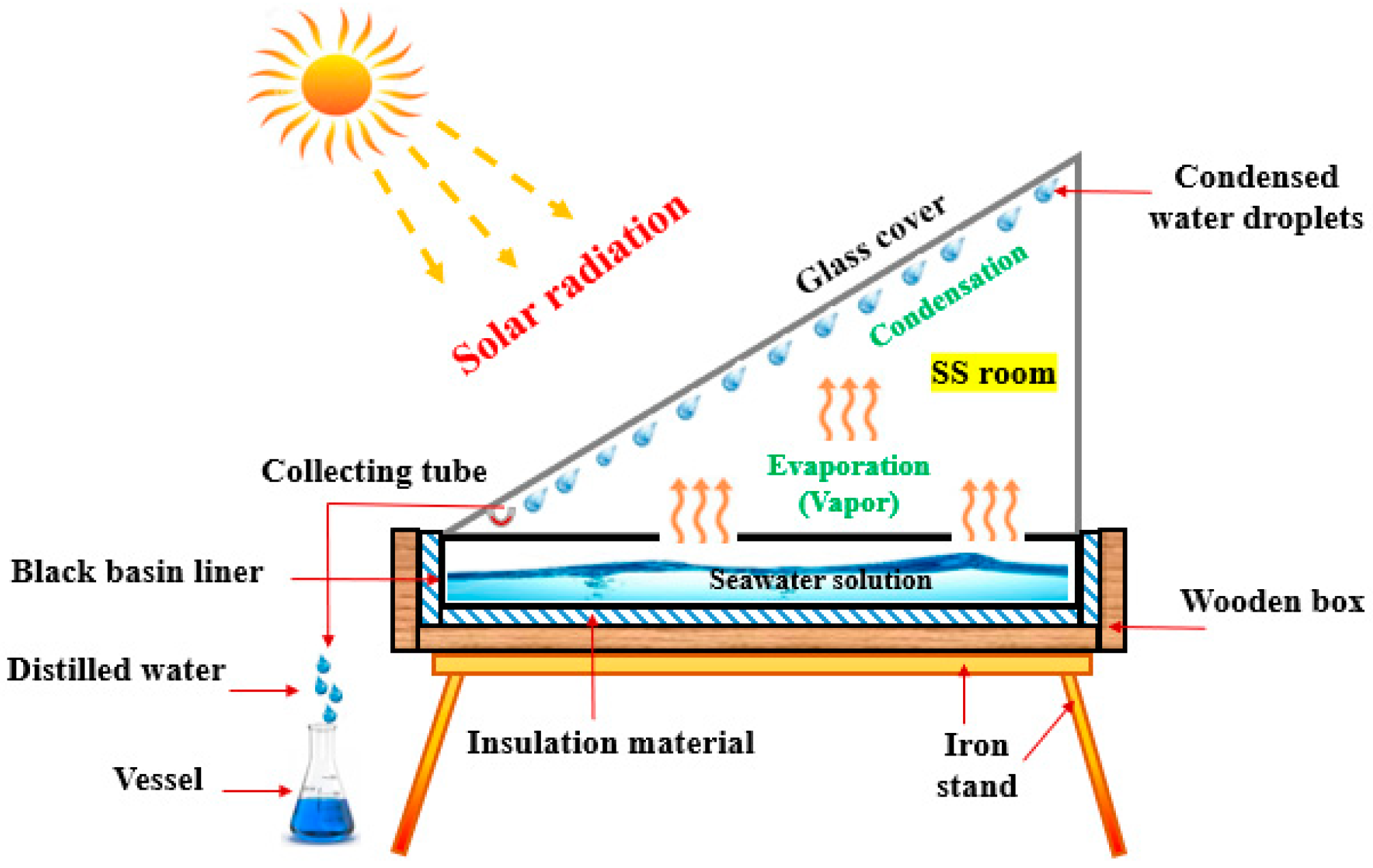
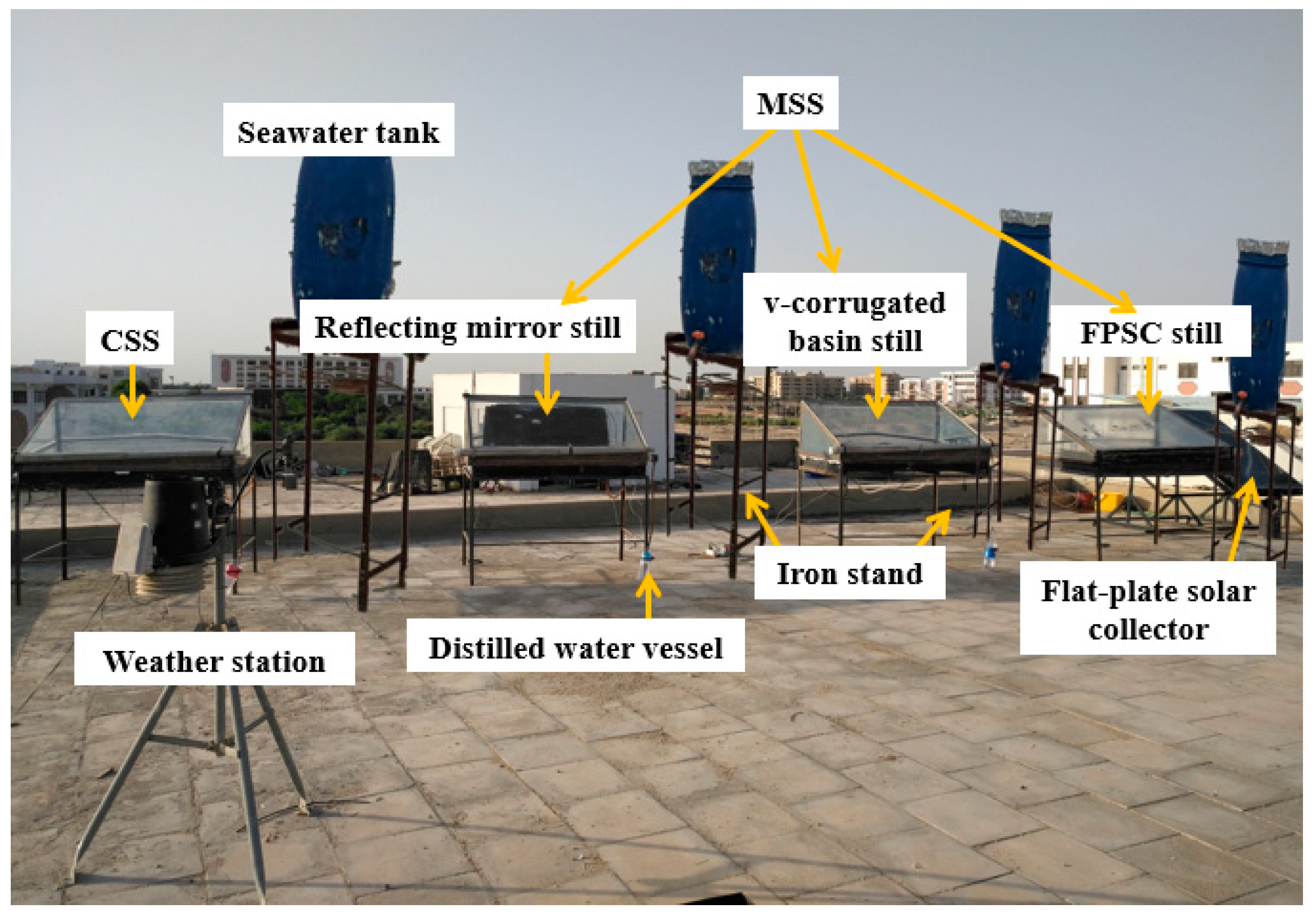
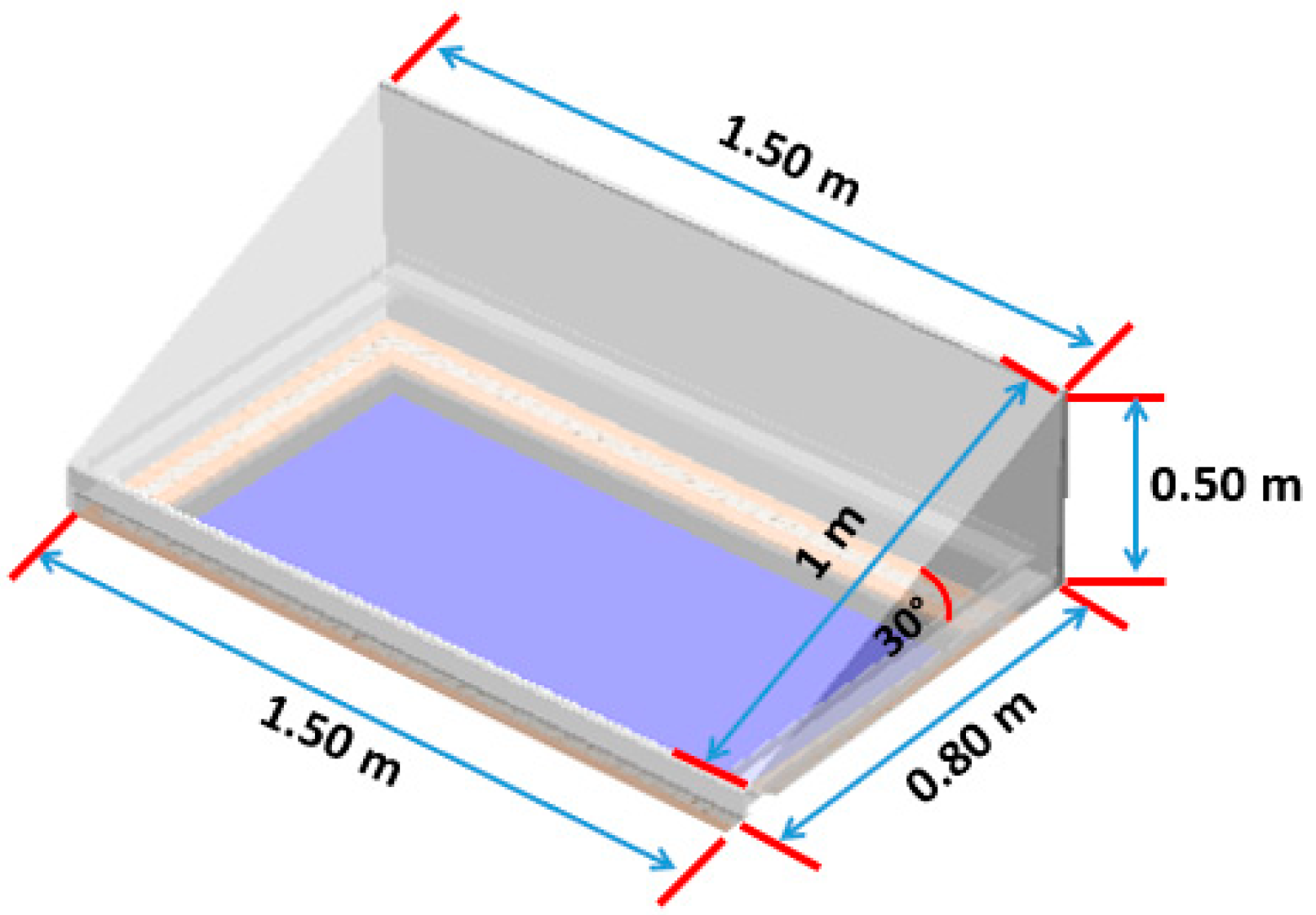
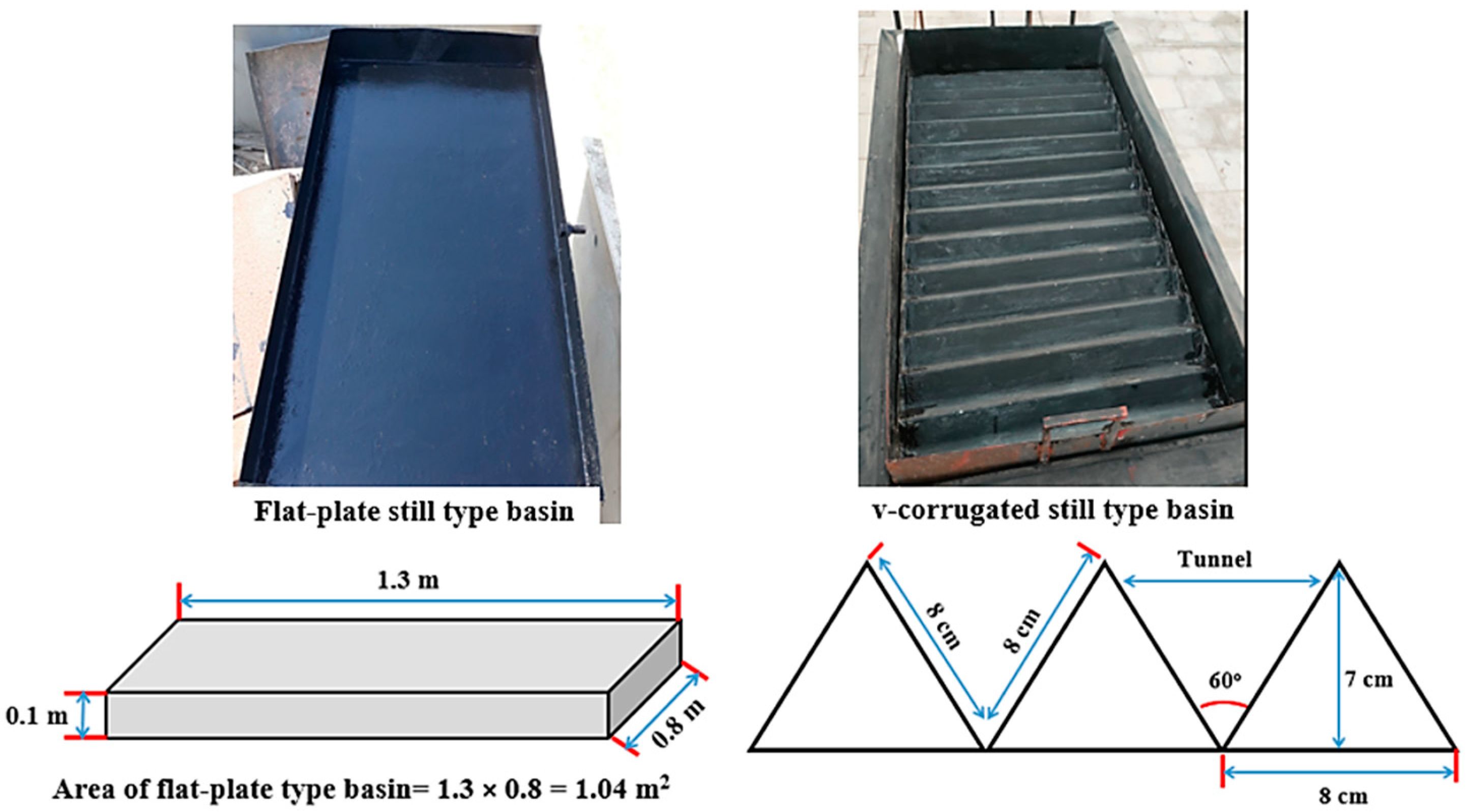

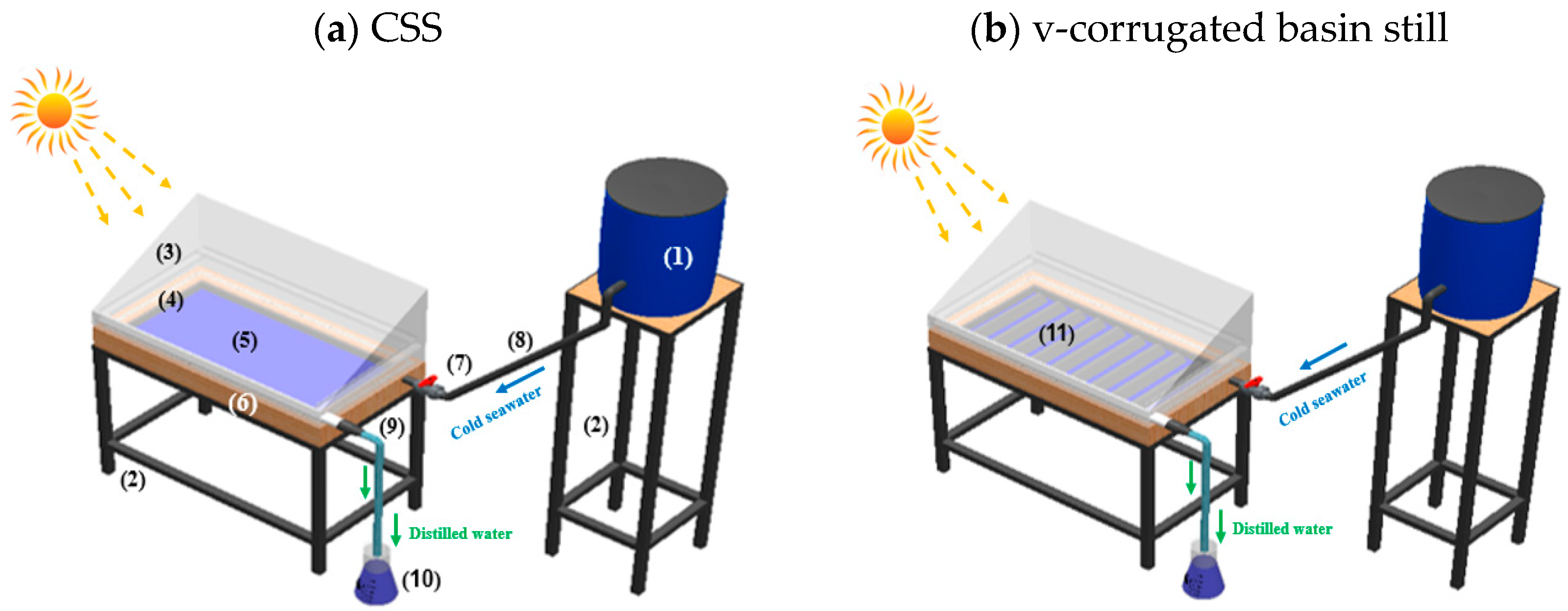
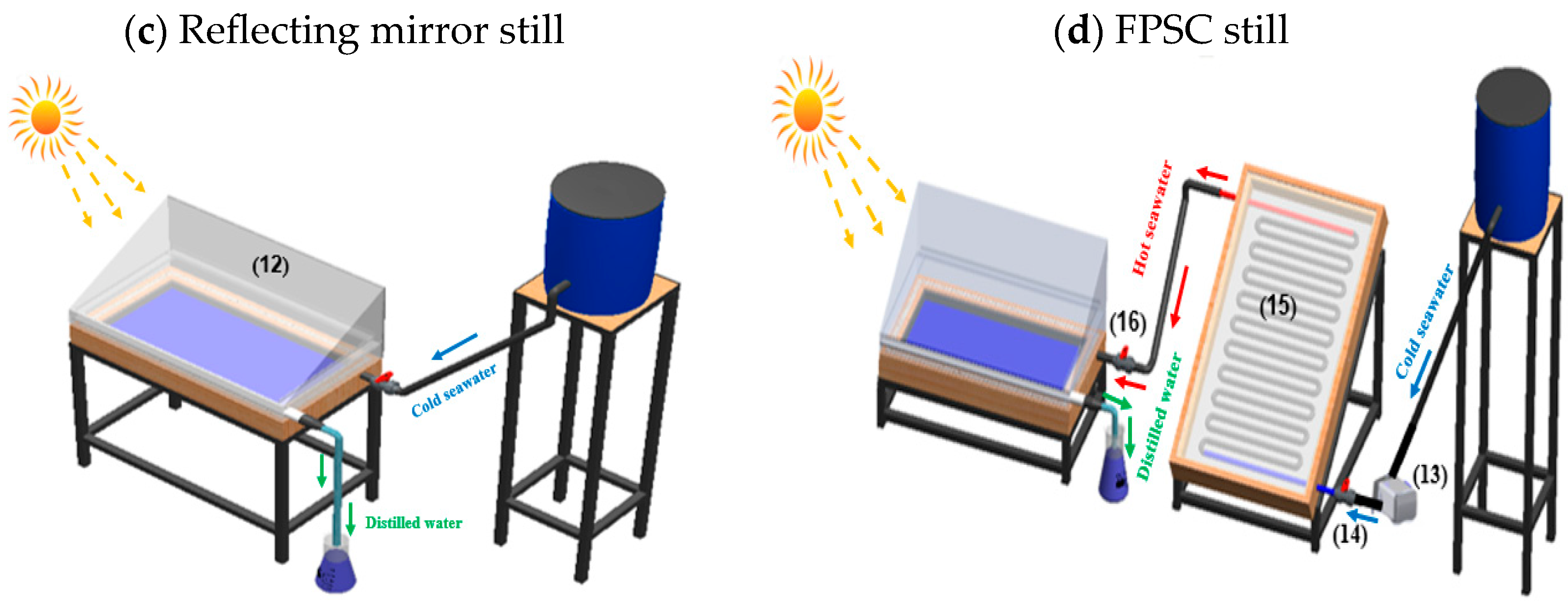


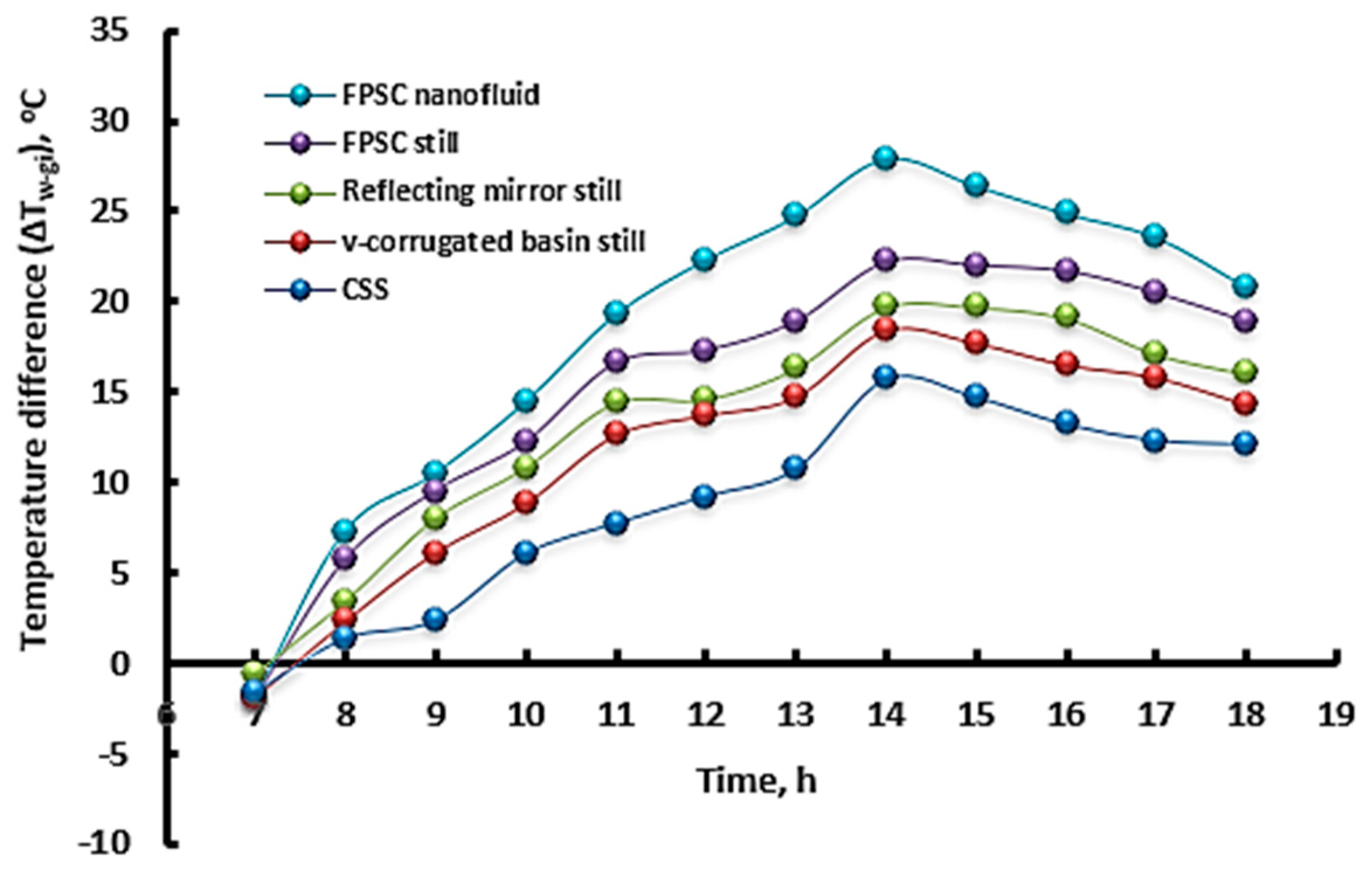
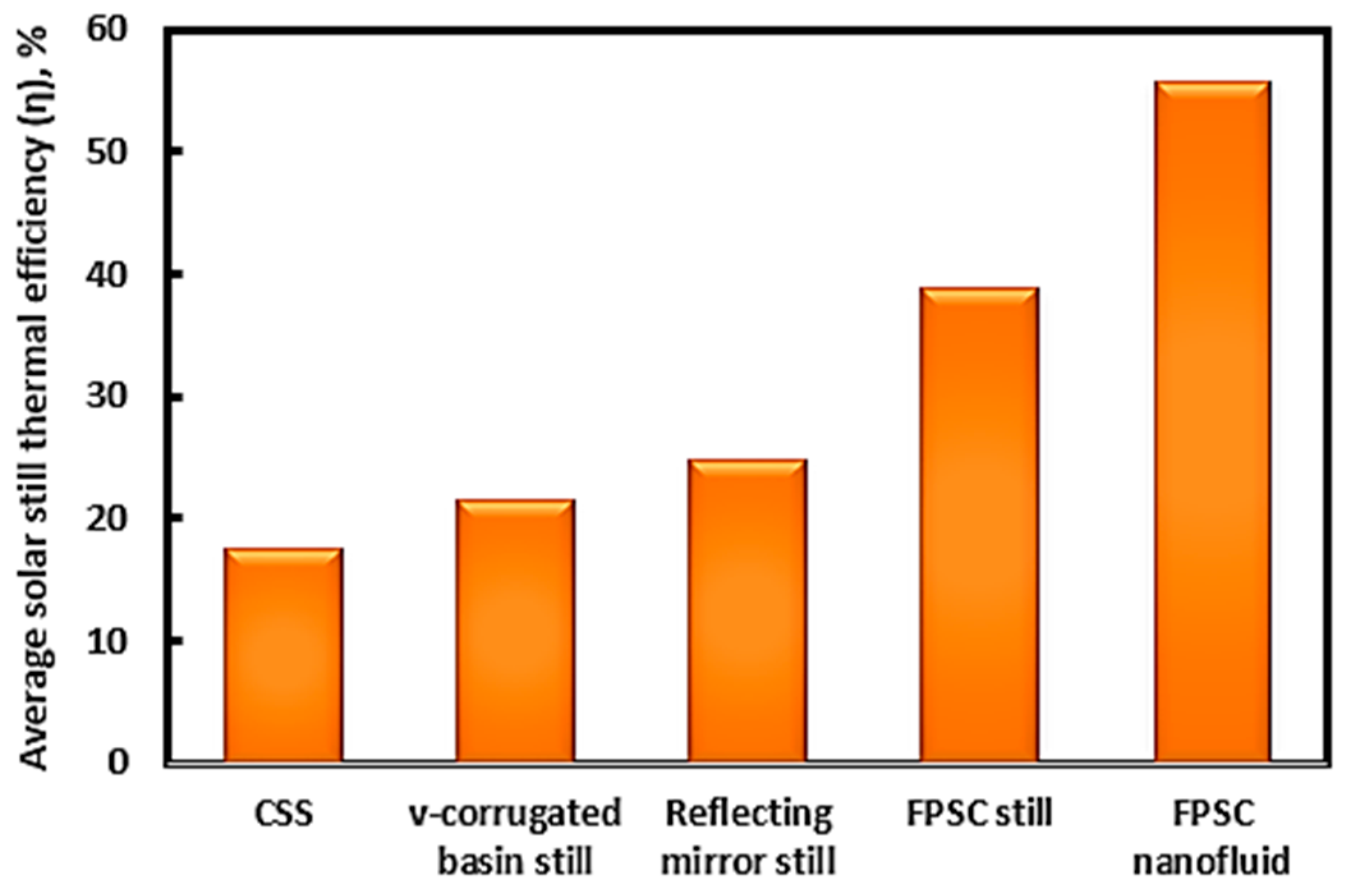
| Density, kg/m3 | Specific Heat, J/kg K | Thermal Conductivity, W/m K | Ref. | |
|---|---|---|---|---|
| Al2O3 | 3995 | 880 | 35 | [37,38] |
| seawater | 1025 | 4007 | 0.60 | [37,38] |
| Property | Value |
|---|---|
| Volume concentration ϕ, (% vol.) | 3 |
| Density ρ, (kg/m3) | 1088 |
| Thermal conductivity k, (W/m.K) | 0.67 |
| Average particles size, (nm) | 45 |
| Zeta potential, (mV) | −27.71 |
| Instrumentations | Measurable Variable | Accuracy | Rang | Standard Uncertainty |
|---|---|---|---|---|
| Pyranometer | solar intensity | 0.04 W/m2 | 0–2300 W/m2 | 2.36 × 10−2 W/m2 |
| Thermocouples | Nanofluid temperatures | ±0.17 °C | (0–150) °C | 7.3 × 10−2 °C |
| Infrared thermometer | SS surface temperature | ±0.12 °C | (−10–200) °C | 4.88 × 10−2 °C |
| Rotameter | Nanofluid flow rate | 0.03 L/min | 0.01–0.5 L/min | 0.001 L/min |
| Various Solar Still Configurations | Average Different Temperatures (°C) | ||
|---|---|---|---|
| Tw | Tgi | Tv | |
| CSS | 54.03 | 42.95 | 51.57 |
| v-corrugated basin still | 60.72 | 45.94 | 57.52 |
| Reflecting mirror still | 66.58 | 50.02 | 63.15 |
| FPSC still | 72.29 | 53.75 | 69.05 |
| FPSC nanofluids | 86.75 | 64.51 | 82.86 |
| References | Various Enhancements of Solar Still Configurations | Improvement in Productivity (%) | Thermal Efficiency (%) | Operating Conditions |
|---|---|---|---|---|
| Current study | V-corrugated basin | 22.39 | 22.01 | Average Tao = 30.9 °C, average I = 506.9 W/m2, water depth = 2 cm, Seawater salinity = 33,162 ppm, single slope solar still. |
| Internal reflecting mirror | 41.72 | 26.71 | ||
| FPSC still | 70.10 | 39.57 | ||
| FPSC nanofluids (Al2O3/water) | 104.13 | 56.21 | ||
| [9] | V-corrugated basin | 21 | 41 | Wind speed = 0.4 to 4.3 m/s, solar intensity = 20 to 1100 W/m2. Water depth = 50 mm, quantity of saline water =30 and 50 L, single slope solar still. |
| [50] | Internal reflecting mirror | 75 | 56 | Saline water depth = 5 mm, stepped solar still. |
| [11] | FPSC still | 20.8 | 20.4 | Fresh tap water, V-shaped glass solar still. |
| 24.1 | 23.6 | Saline water concentration = 5%, V-shaped glass solar still. | ||
| [13] | FPSC still | 36 | -- | Water depth = 2 cm, single slope solar still. |
| [45] | Fresnel lens concentrator nanofluids (Al2O3–Therminol-55 nanofluid (nHTF)) | -- | 53.55 | Flow rate of nHTF = 0.5 L/min, saline water depth = 25 mm, solar intensity = 764 to 770 W/m2, single slope solar still. |
| [51] | Blackened stainless steel balls: 1. 10 mm diameter | 38.07 | 27.81 | Brackish water salinity = 1850 ppm, water depth = 15 mm, single slope solar still. |
| 2. 5 mm diameter | 31.41 | 26.56 | ||
| Internal reflecting aluminum foils | 14.87 | 23.32 | ||
| [52] | Nano Fe2O3 particles (NALSS) | 53.49 | 30.76 | Ferric oxide density = 5.24 g/cm3, solar irradiation varied from 125 to 712 W/m2, water depth = 0.5 cm, single slope solar still. |
| [53] | Different heat localization materials: 1. (HSHLM)-exfoliated graphite flakes with wick (Type A) | 34.48 | 37.68 | Maximum solar irradiation = 950 W/m2 (at 12:30 p.m.), average air temperature = 32 °C, saline water from Mediterranean Sea, water depth = 1 cm, single slope solar still. |
| 2. (HSHLM)-carbon foam with wick (Type B) | 28.57 | 28.89 | Maximum solar irradiation = 945 W/m2 (at 12:30 p.m.), average air temperature = 25 °C, saline water from Mediterranean Sea, water depth = 1 cm, single slope solar still. | |
| 3. (HSHLM)-exfoliated graphite flakes with wick and carbon foam (Type C) | 51.78 | 47.24 | Maximum solar irradiation = 970 W/m2 at 12:30 p.m., average air temperature = 31 °C saline water from Mediterranean Sea, water depth = 1 cm, single slope solar still. | |
| [54] | Various corrugated absorber shapes: 1. Flat absorber (HSD-FA) | 16.67 | -- | Brine water, water depth = 1.5 cm, average solar intensity = 654 W/m2, average climate temperatures = 38.9 °C, hemispherical solar still (HSD). |
| 2. Square corrugated absorber (HSDSA) | 27.08 | -- | ||
| 3. Semi-circular corrugated absorber (HSDSCA) | 39.58 | -- | ||
| 4. Triangular corrugated absorber (HSDTA) | 48.96 | -- | ||
| [55] | 1. V-corrugated iron tray HSD | 42.85 | 48.28 | Average solar intensity = 619.3 W/m2, average air temperature = 38.2 °C, and hemispherical solar still (HSD). |
| 2. Flat iron tray HSD | 14.30 | 38.72 | ||
| 3. Wick materials with v-corrugated iron tray | 83.12 | 61.67 | ||
| 4. Wick materials with flat tray | -- | 52.16 | ||
| [56] | Different porous absorbing materials: 1. Natural luffa fiber (NLF) | 56.14 | 21.22 | The solar radiation ranged from 400 to 995 W/m2, seawater salinity = 15,300 ppm, single slope solar still. |
| 2. Black luffa fiber (BLF) | 77.61 | 24.71 | ||
| 3. Fine steel wool (FSW) | 98.29 | 28.60 | ||
| 4. Steel wool pads (SWP) | 134.18 | 32.74 | ||
| [57] | Thermal CPC collector, photovoltaic panel, TES (quartz sand) and distiller basin material (tarnished copper) | 91 | -- | Maximum solar irradiation of 845 W/m2 at 12 p.m., average air temperature = 18 °C, seawater mass of 35 kg, single slope solar still. |
| [58] | Various energy storage materials: 1. 5 kg of fine sand (0.125–0.25-mm grain size) | -- | 50.69 | Average solar irradiance = 680, 683, and 689 W/m2, daily average ambient temperature during the experimentations is between 35 and 37 °C, water depth = 0.5 cm, tubular solar still (TSS). |
| 2. Small gravels (20–30 mm) | -- | 61.13 | ||
| 3. Black granite (5-mm thickness) | 10.5 (compared to gravel) | 67.09 | ||
| 32.3 (compared to sand) |
Disclaimer/Publisher’s Note: The statements, opinions and data contained in all publications are solely those of the individual author(s) and contributor(s) and not of MDPI and/or the editor(s). MDPI and/or the editor(s) disclaim responsibility for any injury to people or property resulting from any ideas, methods, instructions or products referred to in the content. |
© 2024 by the authors. Licensee MDPI, Basel, Switzerland. This article is an open access article distributed under the terms and conditions of the Creative Commons Attribution (CC BY) license (https://creativecommons.org/licenses/by/4.0/).
Share and Cite
Abu-Zeid, M.A.-R.; Elhenawy, Y.; Toderaș, M.; Bassyouni, M.; Majozi, T.; Al-Qabandi, O.A.; Kishk, S.S. Performance Enhancement of Solar Still Unit Using v-Corrugated Basin, Internal Reflecting Mirror, Flat-Plate Solar Collector and Nanofluids. Sustainability 2024, 16, 655. https://doi.org/10.3390/su16020655
Abu-Zeid MA-R, Elhenawy Y, Toderaș M, Bassyouni M, Majozi T, Al-Qabandi OA, Kishk SS. Performance Enhancement of Solar Still Unit Using v-Corrugated Basin, Internal Reflecting Mirror, Flat-Plate Solar Collector and Nanofluids. Sustainability. 2024; 16(2):655. https://doi.org/10.3390/su16020655
Chicago/Turabian StyleAbu-Zeid, Mostafa AbdEl-Rady, Yasser Elhenawy, Monica Toderaș, Mohamed Bassyouni, Thokozani Majozi, Osama A. Al-Qabandi, and Sameh Said Kishk. 2024. "Performance Enhancement of Solar Still Unit Using v-Corrugated Basin, Internal Reflecting Mirror, Flat-Plate Solar Collector and Nanofluids" Sustainability 16, no. 2: 655. https://doi.org/10.3390/su16020655
APA StyleAbu-Zeid, M. A.-R., Elhenawy, Y., Toderaș, M., Bassyouni, M., Majozi, T., Al-Qabandi, O. A., & Kishk, S. S. (2024). Performance Enhancement of Solar Still Unit Using v-Corrugated Basin, Internal Reflecting Mirror, Flat-Plate Solar Collector and Nanofluids. Sustainability, 16(2), 655. https://doi.org/10.3390/su16020655









